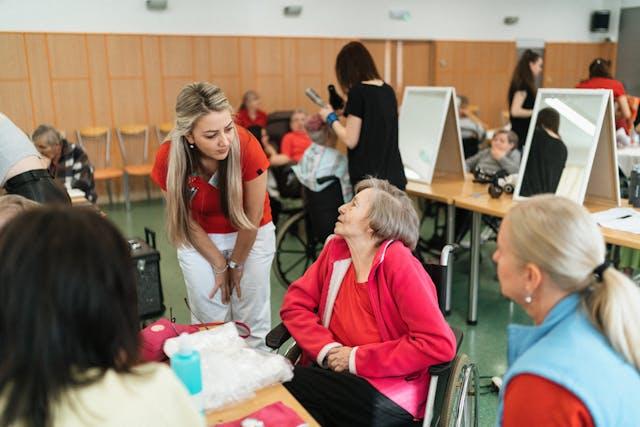Tips for Staying Focused While You Work Remote During Retirement

Are you one of the many Americans performing remote work during retirement? Remote work is an attractive option for older folks because of its flexibility and convenience.
However, it can be difficult sometimes to stay focused when working from home. In this article, you’ll find several tips on ways to be better focused on your job, such as having a dedicated workspace, creating your schedule with intention, and practicing quality self-care.
Create a Designated Workspace
Having a designated workspace is critical for staying focused while working remotely. A designated space allows you to:
- Focus
- Mentally prepare your brain for “work mode”
- Minimize distractions
- Create more balance between working and resting at home
A report from the Harvard Business Review shows that if you’re not careful with creating boundaries between work and home life when working remotely, it won’t be long before you’re unable to relax and unplug within your own home.
Here are some ways you can create a comfortable designated workspace.
Use a Spare Room
If you have a spare room in your home, set up your home office/workspace location there. You should avoid setting up your workspace in your bedroom if possible in order to help your brain relax after work.
Depending on your job, you may want a well-lit area for video conferences and meetings. Kitchens and dining rooms usually have the best lighting.
Keep Your Workspace Organized
It’s natural for your workspace to get disorganized or cluttered throughout the day. Spending a few minutes decluttering and organizing at the end of the workday can help ensure you start your next day fresh and prepared.
Make It Comfortable and Welcoming
You should work in a space you actually want to work in, since it’s especially challenging to focus when you’re uncomfortable.
Some ways to make your workspace area comfortable and welcoming include:
- Displaying pictures of your loved ones or art you enjoy
- Adding plants
- Having adjustable lights so you can brighten or dim the settings as needed
- Sitting in a comfy chair that supports your back
You can also consider investing in a standing desk to get some movement in as needed.
Establish a Routine
It can be hard to separate work from home life when you do remote work during retirement. Keeping both these sides of life separate through an established routine will help you not only unplug and relax better off the clock but also focus during work hours.
Start and End Work at the Same Time Daily
One of the benefits of remote work is its flexibility. In many cases, you have some degree of wiggle room when starting or finishing work for the day. It can be tempting to start and finish work whenever you want, but a solid routine will help you focus and be more productive.
Start work at the same time every day and end at the same time every day. Make sure your friends and family know what your work hours are so they know when you are unavailable.
On the same note, make sure your colleagues also know what your established work hours are so they know when to reach out to you. This minimizes being contacted about work outside of work hours, allowing you to better focus on your personal life.
Routines Help Your Brain
Your brain learns from routine. If you have a pre- and post-work ritual, you are teaching your brain to understand when work mode should begin and end.
The better your brain understands work mode, the easier it will be for you to focus during work.
Avoid Distractions
When you get distracted, it can take as long as 20 minutes for you to refocus on the task in front of you. This is why it’s important to avoid distractions while working remotely.
Here are some ways you can avoid distractions at home.
Keep Your Cell on Do Not Disturb
If your job doesn’t require you to answer phone calls, you should practice keeping your cell on do not disturb.
If you have an iPhone, you can use its native “focus” features to control who can contact you, how they contact you, and what apps are allowed to send you notifications during a customized “focus” mode.
For example, you can set your work “focus” mode to allow calls from your spouse in case of an emergency but block all other calls. You can set it so you don’t receive notifications from social media or news apps during your working hours.
If your phone doesn’t come with a fancy “focus” mode feature, you can simply put it on airplane mode, turn it off, or put it in another room away from your workspace.
Communicate with Your Peers
This tip goes hand-in-hand with the previous tip of establishing a routine. When you have an established set of work hours, communicate those hours to your friends and family and ask them not to distract you during that time.
Keep TVs out of Your Space
Keep TVs or other electronics out of your workspace so you’re less inclined to turn them on or get distracted by them.
Try Noise-Canceling Headphones
If you work in a common space where members of your household are bustling about, you can try noise-canceling headphones. You can use these headphones on their own or connect them to a sound that helps you focus.
For example, you can turn on a white noise or brown noise YouTube video on your browser to help block out background noise.
Take Breaks
Taking scheduled breaks can help you avoid mental burnout. Scheduling breaks into your workflow may feel like an additional burden, but they offer numerous benefits:
- You can return to work more focused, having given your brain a chance to relax
- You’ll be more productive since better focus equals greater productivity
- You’ll be better at problem-solving
- You’ll minimize the chances of burnout
It’s challenging to figure out how to take breaks at home. At the office, there are numerous opportunities for breaks, such as grabbing a coffee from the breakroom and stopping by your coworker’s cubicle for a brief chat.
At home, especially if you’ve set up a designated distraction-free workspace, it can be challenging to find a distraction that isn’t too distracting, since you do have to return to work mode after the break.
Here are some ways you can schedule refreshing breaks into your workday that help you come back to your work more focused than before.
Try Exercise
Everyone knows by now how bad extended sitting can be for your body. One of the best breaks you can take when working from home is an exercise break.
You don’t have to do a 45-minute workout routine. It can be something simple, like climbing up and down the stairs a few times or performing a few squats.
If you live in a walkable area, you can do a lap around your block or neighborhood.
Stretch Frequently
Prolonged, repetitive postures result in discomfort, aches, and pains that can worsen your quality of life. A good way to get a quick break from work is to incorporate regular stretching into your routine.
Set a timer for two minutes and shake out your wrists, roll your neck and shoulders, and forward fold to stretch out your lower back and hamstrings. Whatever stretches you do, try to hold them for a minimum of 30 seconds.
Get a Snack
Keep your kitchen stocked with healthy remote work snacks that aren’t laden with sugar. A healthy snack is beneficial because:
- It offers a break from work
- It helps curb hunger to minimize binge eating
- It keeps your blood sugar stable
Snacks provide a natural pick-me-up that can energize you to finish out your workday.
When to Schedule Breaks
You could follow a method called the Pomodoro technique, which is where you take a five-minute break after 25 minutes of working.
These five minutes can be spent stretching, snacking, or hydrating. After three hours, take a 30-minute break, such as lunch or a brisk outdoor walk.
Moving your body for around three minutes every 30 minutes or so can help combat the negative effects of sitting.
Stay Connected with Colleagues
Another important way to focus while doing remote work during retirement is to stay connected with your colleagues with the right tools.
Many people struggle to stay connected with their coworkers and team during remote work because of the physical separation.
An excellent way to combat this is to practice intentional connection. Try following some of the steps below to maintain frequent communication and collaboration.
Try Coffee Chats or Virtual Lunches
It can help to have video meetings where you and any interested colleagues can enjoy some coffee or lunch while chatting.
These chats and lunches are essentially like a virtual breakroom, where you can socialize and catch up while nourishing or hydrating your body. They offer a break from work that allows you to decompress while staying connected with your coworkers.
Start a Group Chat
Group chats are also a great way to stay connected with your colleagues. If you’re working on a project with a specific department, you can have a slack channel where you and your colleagues provide updates, jot down ideas, or check in with each other’s progress.
Participate in Company Challenges
Many companies host contests or challenges to promote work culture among their teams. If your company offers these, consider participating.
Prioritize Self-Care
Self-care is critical for quality remote work during retirement. After all, you’re in retirement! You’ve worked hard your whole life to get to this point, so enjoy it.
Here are some ways to prioritize self-care while working remotely.
Check In on Your Financial Health
Your financial health is a critical aspect of self-care. One way you can practice financial self-care is by checking on your annuity rates to ensure they’re growing and compounding year after year. If you’re not taking advantage of annuities, now’s the time.
Eat Nourishing Foods
Don’t stay so busy that you neglect your physical health by ordering take-out or eating junk food regularly.
Take time out of your day to go to the grocery store, pick up fresh produce, and make some good home-cooked meals.
Get Enough Sleep
Getting enough sleep is critical for focus since the quality of your sleep impacts the health of your brain. Practice good sleep hygiene by having a bedtime routine, keeping your bedroom dark, cozy, and distraction-free, and going to bed and waking up at the same time every day.
Successful Remote Work During Retirement
Focusing on remote work during retirement can be challenging, but there are numerous ways for you to self-manage so you can show up as your best self.
With the right workspace, schedule, and self-care activities, you can have a successful remote work experience.
Thanks for reading! Do you want to create thought leadership articles like the one above? If you struggle to translate your ideas into content that will help build credibility and influence others, sign up to get John’s latest online course “Writing From Your Voice” here.



